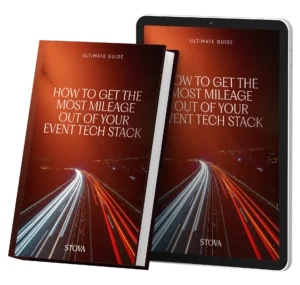Meeting vs. Virtual Event vs. Webinar – Why All Online Interactions Are Not the Same
January 14, 2021
Top-trending words come and go. What’s “cool” today may have been “groovy,” “crackerjack” or the “bee’s knees” ages ago. Look around, and you’ll see other words shared the limelight. Many of them have been around for a while but rose to new relevance as the year unfolded. For example, take mask, remote, quarantine, and social distance.In our industry, a top term of 2020 was “virtual.” It was everywhere as in “virtual event,” “virtual attendees,” “virtual networking,” “virtual studio,” “doing business virtually.” Feel free to add more.
Recommended Resource: Are you trying to determine the right solution for your upcoming digital meetings and events? Stova’s virtual event platform gives you the flexibility to plan both small and large events with ease.
The trouble is, when a word suddenly leaps into our daily lexicon, it can mean different things to different people.
Ask your coworkers how they define a “virtual event.” Is it a meeting? A webinar? A webcast? A live stream? Or something else?
Before you plan your next online event, it’s important to get clear on the terms.
Here to help, this article looks at three words and phrases often used interchangeably and wrongfully so. Then it explains what these terms have come to mean in an era defined by Covid-19.
The words are:
- “Meetings”
- “Webinars”
- “Virtual Events”
You’ll get the full rundown along with key strengths and considerations. So when you plan your next online gathering, you’ll know which format best fits your needs.
Let’s dive in…
What is a Meeting?
Sounds like a simple question, right?
But forget conference rooms and business lunches. With so many people working remotely, meetings today are likely to take place on platforms like Zoom, Google Meet and Webex.
Meeting platforms are great for hosting interactive sessions with audience participation. They also enable you to break up sessions into smaller groups.
The platforms are typically used company-wide and managed by the IT department. Unlike virtual events or webinars, these gatherings are often internal with no specific marketing goal.
Strengths
- Simplicity: Meeting platforms are easy to master, as shown by their meteoric rise this year. There’s no attendee registration. The only requirement is integration with email.
- Engagement: Meeting platforms encourage interaction with features like chat; Q&A’s; polling; mute/unmute; recording; and screen, video, and audio sharing.
- Flexibility: Meetings can be one-on-one or collaborative, scheduled in advance or on the spot.
- Cost: Options are available for every budget, from free to well-priced enterprise plans. Adding to the savings, this format eliminates expenses for travel and meals.
- Efficiency: With no need for much preparation, meetings are a convenient way to bring remote workers together and make everyone feel like part of the team.
Considerations
- Visibility: Attendees can be out of sight to the host and other participants. This limits interactions. With cameras turned off, hosts get little feedback. Are attendees tuned in or out? Did they stay for the whole meeting, or log on and then do something else?
- Tracking: Meetings lack robust analytics and reporting capabilities. As you’ll see later in this article, hosts miss opportunities to gain insights on attendee preferences and buying intent.
What is a Webinar?
A webinar is like a virtual seminar. This format has been around for 20 years, and no wonder. It’s a great way to share content with external audiences.
Typically, a webinar offers basic registration for a single session with a marketing objective. Organizations count on webinars to build awareness, establish thought leadership, boost conversions, and more.
Because webinars tailor to a different audience than meetings, webinar platforms offer more attendee tracking capabilities.
Strengths
- Engagement: Webinars offer many features for engaging presentations. Host and panelists can share their screens, audio, and video. Other interactive features include chat, Q&A’s, whiteboard, annotation, polling, audio/video streaming, and recording.
- Savings: Webinars eliminate costs for travel, catering, meeting space, and audio-visual rentals. They save time, too. Most require less preparation and promotion than face-to-face or virtual events.
- Reach: Content is available in real-time or on-demand. This makes webinars a great way to reach large audiences across time zones.
Considerations
- Networking: Typically, attendees don’t interact with each other. A presenter or host and panelist will speak to the audience. Attendees submit questions through chat and Q&As. A moderator manages questions for the presenter or panelists to answer.
- Duration: Webinars have limits based on how long you can hold the attention of people sitting at their computers with little participation. Best to keep webinars to no more than an hour.
What is a Virtual Event?
Virtual events are quite simply events held online. They use Web platforms to bring dozens to thousands of people together either for a few hours or potentially for multiple days over weeks or even months.
These events are for internal or external audiences and have marketing or training goals. Participants connect, exchange ideas, and enjoy shared experiences. All they need is an Internet connection and a computer or smart device.
Complexity is what distinguishes digital events from online meetings and webinars.
Think of a virtual event as a group of webinars and meetings. Many digital events start with a keynote (similar to a webinar) and follow up with breakout sessions (resembling meetings). Virtual events can last hours or days and feature single- or multi-track agendas.
Unlike meetings and webinars, virtual events offer robust attendee registration. Choose from free or paid, with various pricing options. For example, tiered pricing allows for different levels of access to content at different price points. You can utilize categories for additional segmentation of your attendee list; examples might include sponsors, CMOS, or event planners. This allows virtual events to do a better job of managing attendee “intent,” so you can truly understand what drives these specific attendee types.
Because of the complexity of events, virtual event platforms offer more advanced capabilities than webinar platforms. These virtual event platforms have a wide range of feature sets, some basic and some comprehensive, covering the entire event lifecycle.
Now let’s look at other similarities and key differentiators…
Strengths
- Savings: Virtual events eliminate costs for meeting space, accommodations, setup and takedown, travel, meals, and more. Like meetings and webinars, they also take less time to plan than in-person events.
- Engagement: Distractions abound for online attendees, not to mention the extra challenges of working from home. Compared to meetings and webinars, virtual events offer more features to keep attendees engaged.
For example, real-time polls and surveys help speakers customize their sessions to audience needs. Chat, Q&A’s, and gamification break up sessions and make attendees feel like they’re part of the conversation. Smart marketers boost engagement in creative ways, such as mini-yoga sessions and live music breaks with DJs.
- Revenue: Virtual events offer many sponsorship opportunities, too. Showcase sponsors in your virtual event lobby, main stage, and exhibition hall. Offer sponsored sessions, networking lounges, and gamified challenges. Also, create digital libraries of recorded content and provide access through individual and group packages.
- ROI: Attendee tracking is more robust with virtual events versus meetings and webinars. Why is this important?
Measuring return on investment at in-person events has always been difficult. Now, with resources stretched thin, proving ROI has never been more important.
Fortunately, modern tools simplify this effort. Solutions like Stova Virtual Event Platform track actions throughout the event lifecycle. Measure email opens unique visits, downloads, questions, leads, conversions, and more. Using powerful reporting tools, you can quickly demonstrate value to stakeholders.
- Insights: Drill down to find the most engaged attendees. Uncover top-performing sessions by combined attendee evaluations and content usage. Analyze session selection and dwell time to see where attendees are in the buyer’s journey. Savvy organizers use this intelligence to optimize their event and marketing programs moving forward.
Considerations
- Networking: Of course, networking is the main reason people go to events. Virtual platforms can’t replicate the in-person experience, but they do enable personalized, one-on-one connections.
Modern solutions bring remote attendees together with virtual networking lounges, cocktail parties, and group chats. Many platforms offer features like filterable attendee lists, personalized connection recommendations, meeting scheduling, and video chat. So remote attendees can make the most of their time at events.
- Exhibitor engagement: Interactions between online attendees and exhibitors can be a challenge. With traditional solutions, attendees must use different tools and often wait hours in a queue before connecting with an expert.
Fortunately, new technology changes the game for the better. For instance, Stova Digital Lead Capture brings immediacy to networking and exhibitor engagement.
The solution combines features for lead qualification, chat, video conferencing, content delivery, and reporting. Virtual sponsors and exhibitors gain tools and information to qualify prospects and provide immediate value via real-time video conversations and targeted event follow-up.
Recommended Resource: Recreate the experience of connecting event visitors with sponsors and exhibitors at a show floor and facilitate quality conversations via Stova’s digital lead capturing solution complete with integrated video conferencing, lead qualification, and comprehensive reporting.
By definition, Words of the Year come and go. With new vaccines coming into the market, we’re confident terms like “pandemic” will get fewer lookups in the New Year.
But it’s clear, “virtual” is here to stay.
In fact, a recent survey by Stova revealed 89% of organizers plan to make virtual part of their long-term strategies. Even after face-to-face meetings return, many attendees will be unable to travel due to financial or health concerns.
Organizers have discovered that adding virtual components to in-person gatherings is a smart way to go. Among the advantages, this approach can create new revenue streams and expand audiences globally.
That’s why we believe the 2021 guiding words for event marketers will be:
- Virtual
- Hybrid
- In-person
Our next article in this series provides an in-depth look at each of these formats. So stay tuned for tools and tips for success in the coming year.
Whether your event is virtual, hybrid, or in-person, enhance your attendee’s journey with an event ecosystem built for your audience. Ready to walk through Stova's event technology solutions? Schedule some time with us today.


